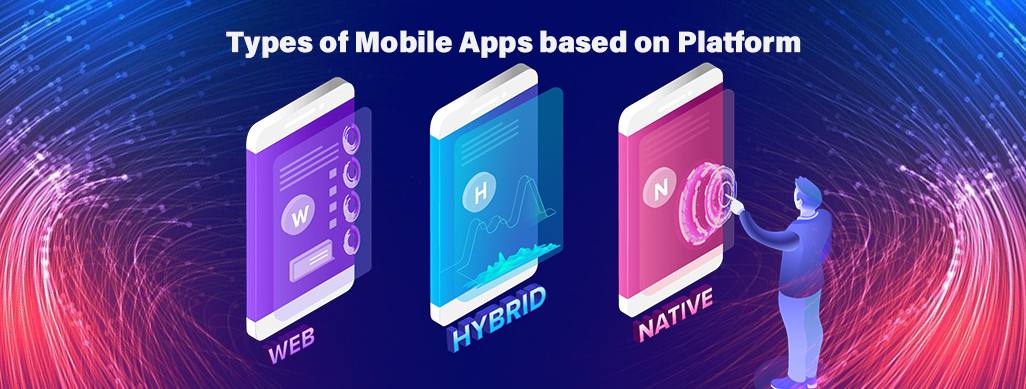
We use cookies to ensure that we give you the best experience on our website.
By using this site, you agree to our use of cookies. Find out more.
In this blog post, we will explore the different types of Mobile Application Development have available based on development platform and targeted industry.

As we step into the new year 2024, mobile applications have become an integral part of our daily lives. Whether it is for socializing, consuming news and media, productivity or entertainment on the go - Mobile Application Development have transformed the way we interact and get things done. With thousands of new apps launching each year across diverse categories, it can be confusing for both users and businesses to choose the right mobile app approach for their specific needs. In this blog post, we will explore the different types of Mobile Application Development have available based on development platform and targeted industry. We will also look at key factors to consider such as functionality, timeline and user experience requirements when determining the suitable mobile app strategy for your goals in 2024.
A mobile application, commonly referred to as an app, is a type of application software designed to run on mobile devices such as smartphones and tablets. Mobile apps are available through distribution platforms called app stores, which are operated by the owner of the mobile operating system. Some examples include Google Play Store (Android), App Store (iOS) and Microsoft Store (Windows). Mobile apps allow users to perform various interactive functions from their mobile device. They can be used for anything from playing games to online shopping, social networking, ordering food, making reservations and payments. Mobile Application Development have provide an enriched digital experience and bring value by making everyday tasks fast, easy and engaging for users on the go. Downloading and using apps have become an integral part of our mobile lives, reflecting how businesses and consumers alike rely heavily on these software programs.
Here are the types of mobile apps based on platform:

Native apps are considered the most optimal type of mobile applications as they are built using the native programming languages specific to each platform. For iOS, apps are developed using Swift or Objective-C languages, while Android uses Java and Kotlin for app development. Since native apps are compiled into platform-specific machine languages, they tend to have best performance compared to other types. They allow seamless integration with the OS and access to all device features like camera, notifications, contacts and more without any limitations.
For businesses, native apps tend to provide the best user experience which is critical for customer satisfaction and engagement. As native apps act and feel like built-in platform features, users find them highly intuitive and easy to use. This enhances brand perception and loyalty towards the company. However, developing separate codes for each platform makes native mobile applications development an expensive and time-consuming process. Businesses require experienced and dedicated mobile applications development teams comfortable with different platforms to create high-quality apps within given timeframes and budgets. Ongoing maintenance like software upgrades and bug-fixing also requires substantial resources. Therefore, native apps are best suited for complex applications and when performance is a top priority for mission-critical use cases.
Web apps are built using web technologies like HTML, CSS and JavaScript which makes them cost-effective to develop as the same codebase can be shared across platforms. They don't require platform-specific coding like native apps. For businesses with tight budgets, web apps present a viable low-cost option to establish a mobile presence. Since web apps utilize the mobile browser, development can start quickly without having to maintain separate codebases. They also have an advantage when it comes to updates, as one update to the webserver rolls out changes to all users.
However, web apps also have limitations compared to native functionality. As they function through the mobile browser rather than being native, aspects like offline usability, access to device features and deep links may have restrictions. The user experience tends to be inconsistent and dependent on individual browser performance. This can impact conversion rates. Progressive Web Apps (PWA) bridge this gap by adding app-like behaviors and offline capabilities to enhance user experience. While not at par with native-level performance, PWAs provide a middle ground solution through features like push notifications, splash screens and installation prompts. For companies with limited budgets but needing consistent cross-platform functionality, PWAs can be a viable option for mobile applications development.
Hybrid apps are developed using hybrid mobile development frameworks like React Native, Flutter or Ionic which allow creating a single codebase for building apps that can run on multiple platforms. This offers a more cost effective solution than native apps as developers only have to write codes once which can then be compiled to different platforms. Hybrid frameworks help bridge the gaps between web and native development by providing access to many device capabilities through APIs. The hybrid code is then wrapped in a native container making the apps feel and function like native applications.
For businesses, hybrid apps provide a good balance between development cost and user experience. With minimal additional effort, the same codebase can be deployed across iOS and Android to expand the target audience. Updates have to be made only in one place and get released for all platforms simultaneously. Additionally, hybrid frameworks are constantly improving their capabilities to offer near-native features. This makes them a practical option for mobile applications development, especially for medium-sized companies looking to introduce cross-platform functionality without burning a hole in their budgets. Though not at par with native experience, hybrids deliver satisfactory performance for many use cases.
Here are the types of mobile apps based on different industries:
Here are how to choose the one which fits best for your business need:
When developing a mobile application, it is important to carefully assess the core functional and technical requirements that the app needs to fulfill. This has a significant influence on the choice of platform and architecture. For instance, apps dealing with complex data workflows and computations may require deep system integrations and higher performanc, favoring native development. On the other hand, simplistic utilities with basic features can leverage web-based solutions. It is crucial for businesses to map user stories and use cases comprehensively during initial planning for Mobile Applications Development.
Functional requirements also depend on factors like data security, connectivity and offline usage needs. For example, banking or healthcare apps requiring robust security may constrain the options. Use of device features influences the platform - a game making extensive graphics/camera may necessitate native for quality experience. Defining functional priorities upfront helps evaluate suitable technologies and compatible frameworks. It also guides roadmapping, resource allocation, collaboration with internal teams on integrations. Clear scoping prevents change requests late in development cycles, avoiding cost and time overruns.
The timeline for an app's launch plays a key role in deciding the development approach during mobile application planning. Native apps involving separate coding for each platform naturally require longer timelines. Whereas cross-platform frameworks facilitate swifter initial provisioning across iOS and Android. For businesses aiming for first-mover advantage or iterative updates, rapid prototyping is paramount.
Web-based technologies allow minimum viable products to be deployed within weeks using agile methods. This enables fast customer feedback collection and integration of learnings. However, such stop-gap solutions may lack stability. Hybrid models offer a workable balance here through single codebases transpilable to multiple Operating Systems. Availability of in-house engineering bandwidth also influences timelines. Outsourcing to specialist mobilization partners can help meet deadlines, though proper scoping and vendor management is essential.
Regular reassessment of evolving requirements and competitive landscapes helps prioritize time or features accordingly. Pivots may be needed to scope raw concepts into deliverable Roadmaps. Iterative development cycles maintain flexibility while ensuring go-live within strict time periods for businesses. Proper estimation and realistic scheduling thus forms a cornerstone of time-critical mobile application development projects.
When developing a mobile app, focusing on user experience should be of prime importance. It is crucial to consider the target user personas, how they will use the app and what will encourage sustained engagement. User research through surveys and prototype testing helps understand information architecture, functionality and usability preferences. This provides valuable inputs for platform choice in terms of performance, features accessibility and interface design standards.
For instance, an app meant for occasional informal use may do well with a web-based solution while one involving complex purchase workflows demands high responsiveness from native code. Streamlined onboarding and seamless daily interactions build rapport while confusing navigation kills retention. It is also important to factor changing consumer behaviors and platform trends over the long app lifecycle. Consistent user experience acrossReleases maintains brand perception.
Several factors influence the UX design -screen sizes, regional expectations, disabilities access. Testing designs with real users iteratively is mandatory for mobile applications development. Their feedback helps prioritize efforts based on actual problems. This leads to intuitive, engaging products fulfilling roles efficiently while enhancing everyday experiences. Focused UX paves the path for organic discovery and high conversions.
In conclusion, there is no single best Mobile Application Development have approach that fits all cases. The right choice depends on your unique business objectives and requirements. Carefully evaluating factors like core features, budget, human resources, updates, distribution platforms and user priorities will help narrow down the options. Start by setting clear objectives and then experiment with prototyping different strategies to validate your decision. While trends and technologies will continue to evolve, hopefully this overview has provided you some perspective on suitable mobile app options to drive your objectives forward in the new year 2024. The key is determining what works best for your vision, so that your mobile presence can effectively fulfill its purpose.
Leave a Comment
Your email address will not be published.